

There are 244 native species on the main list, plus two non-native introduced birds that are not included among the totals (Rock Pigeon, Crested Myna; these are in brackets).
BIRDS
| Whooper Swan | Cygnus cygnus | Two (apparently a pair) were on the freshwater lake (Xiao Bei Hu) at east end of Qinghai Lake on 21 June; they had not been there during an earlier visit. |
| Swan Goose | Anser cygnodies ** | A few were on a lake adjacent to our hotel at Xinghai Reserve; a few pairs had half-grown youngsters. |
| Greylag Goose | Anser anser | Up to 30 were on Xiao Bei Hu during two visits. |
| Bar-headed Goose | Anser indicus | Common around Qinghai Lake; numerous pairs were nesting amongst the gull colony at Bird Island. |
| Ruddy Shelduck | Tadorna ferruginea | Common (up to 300/day) around Qinghai Lake. |
| Common Shelduck | Tadorna tadorna | A few were on lakes at Xinghai Reserve and a very few others were on Xiao Bei Hu. |
| Gadwall | Anas strepera | A few (up to 20/day) on drying ponds at Xinghai Reserve. |
| Falcated Duck | Anas falcata | A very few (up to 4/day) on larger lakes at Xinghai Reserve. |
| Eurasian Wigeon | Anas penelope | Just 3 pairs among the hundreds of ducks on Xiao Bei Hu. |
| Mallard | Anas platyrhynchos | Reasonable common at Xinghai Reserve (up to 50/day) but none were seen despite much scoping around Qinghai Lake & Xiao Bei Hu; it was odd to be in a place with thousands of waterfowl but no Mallards. |
| Spot-billed Duck | Anas poecilorhyncha | A few (up to 20/day) at Xinghai Reserve; this subspecies (A. p. zonorhyncha) has been treated by some as a separate species (Yellow-nibbed Duck). It is separated from other Spot-billed Ducks by more uniform sooty black upperparts, dark gray tertials, blue not green speculum and absence of a pinkish loral spot. It is a long distance migrant. |

Bar-headed Goose 18 June 2004 Bird I., Qinghai Lake |
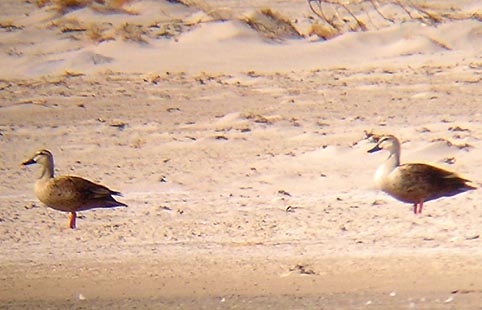
Spot-billed Duck 12 June 2004 at Xinghai Reserve |
| Northern Shoveler | Anas clypeata | A very few (up to 6/day) at Xinghai Reserve and one male on Xiao Bei Hu where it must be rare in summer. |
| Northern Pintail | Anas acuta | Just one pair at Xiao Bei Hu. |
| Common Teal | Anas crecca | Scarce (just 3) at Xinghai Reserve. |
| Red-crested Pochard | Netta rufina | Common but skittish around Qinghai Lake where rafts of up to 300/day were observed in the distance. |
| Common Pochard | Aythya farina | Conspicuous at Xinghai Reserve (up to 30/day on the drying lakes) and common around Qinghai Lake & vicinity (up to 300/day). |
| Tufted Duck | Aythya fuligula | Large rafts (up to 200/day) on saltwater at Qinghai Lake. |
| Common Goldeneye | Bucephala clangula | One female was a rare summerer on Xinghai Reserve; small numbers (up to 10/day) around Qinghai Lake. |
| Common Merganser | Mergus merganser | A male and two females seen on different days during visits to freshwater Xiao Bei Hu. |
| Red-breasted Merganser | Mergus serrator | A single male was on Xiao Bei Hu 21 June; this is presumably a very rare summer species here. |
| Tibetan Snowcock | Teraogallus tibetanus ** | It took some time to spot them after we heard the curlew-like cries just after dawn but we scoped a pair of adults with 5 precocial young high on a bare slope above Huzu Pass (11100' elev.). Impressive birds! |
| Przevalski's Partridge | Alectoris magna ** | A half-dozen were seen or heard (I saw 3) on dry steep slopes above an arroyo in the arid Caka Valley at dawn. They sound and act just like Chukar A. chukar. Paul Holt believes this taxon should be lumped with Chukar but both Clements and Howard & Moore currently split it. It was difficult in the backlit conditions to see the chestnut necklace stripe that distinguishes this taxon from Chukar. |
| Daurian Partridge | Perdix dauurica ** | Reasonably common in open natural habits in Jilin Province; both in the grasslands north of Baichengzhi and at Xinghai Reserve. They rather strongly recall Gray Partridge P. perdix in everything but the chest pattern but there is no talk of lumping these. |
| Tibetan Partridge | Perdix hodgsoniae ** | A fine partridge found in scrub of an arid canyon near Lake Qinghai. We heard a pair but initially could not see them. The group gave up when the birds did not respond to tape. I asked if I could climb up after them and did so; I was treated to superb views of a calling male. Later we all got brief looks at another pair. |
| Japanese Quail | Coturnix japonica ** | I saw one flush from our jeep's passage in grasslands above Baichengzhi and later our group flushed this one or another while walking in the grass. |
| Blood Pheasant | Ithaginis cruentus ** | A prime highlight of the entire trip was spending an astonishing half-hour watching two males forage and interact — while they called to a couple of unseen others — in mixed fir-hemlock-birch forest near our campsite at Huzu Bei Shan. The race here is michaelis; it has an unexpected brushy tuft of unruly feathers sticking out of the nape. The two fully adult males foraged side-by-side in the undergrowth but would interrupt those pleasantries to occasionally cackle or jump at each other! |
| Blue Eared-Pheasant | Crossoptilon auritum ** | I ended up seeing five different birds — and heard more — at high elevation at Huzu Bei Shan. Adults foraged in the early morning in small meadows and were rather tame. These are big impressive pheasants! |
| [Koklass Pheasant | Pucrasia macrolopha * | We heard a couple in thick steep woods at the mountain resort of Wulingshan; one male responded to Paul's tape and approached closely but we were keenly disappointed when views were impossible to obtain.] |
| Common Pheasant | Phasianus colchicus ** | After seeing literally thousands of introduced 'Ring-necked Pheasants' in North America and Europe it was very gratifying to actually 'count' this species on my life list. Wild native birds were found widely in native habitats at Wulingshan; at various spots in Jilin Province; and scattered across Qinghai Province. The Wulingshan birds lived deep in the woods and were quite hard to see, but they did have wide neck rings; the race here is karpowi. Others frequented more open country (like in U.S.) but those up at Huzu Bei Shan were also forest birds that foraged in meadows early in the morning. This dark race (vlangallii) lacks any neck ring. |
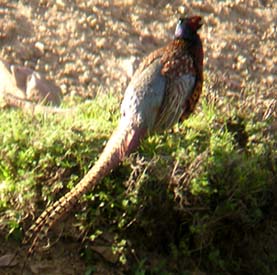
Common Pheasant P. c. vlangallii 22 June 2004 at Huzu Pass, n. Qinghai |
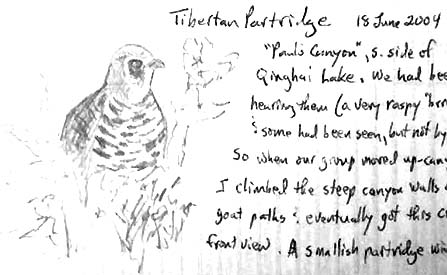
sketch of Tibetan Partridge (and portion of details) 18 June 2004 on south side of Qinghai Lake |
| Chinese Grouse | Bonasa sewerzowi ** | A male was seen startlingly well in the woods near our camp at Huzu Bei Shan. It was spotted first by Arnie as it crossed our track and then responded to Paul's tape; it walked up a diagonal limb to look us over three times [I drew a field sketch; page one of trip report]. The next day another pair were heard (and seen by some) in another canyon nearby. Clements has this in the genus Bonasa — like Ruffed Grouse — but others place it in its own genus Tetrastes. We did hear a Ruffed Grouse-like 'drum' at one point. |
| Little Grebe | Tachybaptus ruficollis | A few pairs were feeding precocial young at Beijing's Summer Palace; others (up to 20/day) were at Xinghai Reserve. |
| Great Crested Grebe | Podiceps cristatus | Courting pairs were scattered around Xinghai Reserve and vicinity but truly remarkable was the huge nesting colony (200+ pairs) with nests on Xiao Bei Hu. |
| Eared (Black-necked) Grebe | Podiceps nigricollis | Fair numbers (up to 30/day) scattered about Xinghai Reserve and a few (up to 10/day) around Qinghai Lake. |
| Great Cormorant | Phalacrocorax carbo | Big numbers (up to 300/day) were seen foraging or in flight out on Qinghai Lake where there are huge nesting colonies that we did not visit. |
| Gray Heron | Ardea cinerea | A few (up to 15/day) scattered about Xinghai Reserve but just two on just one day high on the Qinghai Plateau near Qinghai Lake. |
| Purple Heron | Ardea purpurea | A few (up to 10/day) in the remaining wet marshes at Xinghai Reserve. |
| Great Egret | Ardea albus | One lone bird at the wettest marsh left on Xinghai Reserve. |
| Chinese Pond Heron | Ardeola bacchus | Small numbers (15/day) on the lily pads at the Summer Palace in Beijing. |
| Black-crowned Night-Heron | Nycticorax nycticorax | Good numbers (up to 45/day) at Beijing's Summer Palace and others seen in flight at dawn or dusk around Beijing. |
| Yellow Bittern | Ixobrychus sinensis | A couple among the lily pads at the Summer Palace in Beijing. |
| Schrenck's Bittern ** | Ixobrychus eurhythmus | A major surprise was my spotting one of these attractive little bitterns in flight at Beijing's Summer Palace; it landed in nearby reed beds for fabulous scope views. Then we found another in a reedy marsh at Xinghai Reserve. After our group had drifted away and I undertook some slow stalking I got some stunning digiscoped photos. These were very unexpected highlights! |
| Great Bittern | Botaurus stellaris | One heard 'pumping' in a reedy marsh on Xinghai Reserve; sounds very like American Bittern to me. |
| Eurasian Spoonbill | Platalea leucorodia | One lone bird on the wet marsh at Xinghai Reserve (but unfortunately Oriental Storks Ciconia boyciana had departed the drying marshes the month before). |
| Oriental Honey-Buzzard | Pernis ptilorhynchus | A single late migrant over Wulingshan on 10 June. |
| Black Kite | Milvus migrans | A few were seen around Qinghai Lake and in Caka Valley. The breeding form here (lineatus) is treated by some as a separate species ("Black-eared Kite") but apparently there is extensive hybridization in a broad area of contact. |
| Himalayan Griffon | Gyps himalayensis | A few were seen over the ridges up on the Qinghai Plateau. |
| Lammergeier | Gypaetus barbatus ** | An unexpected highlight was a curious adult that glided down just over us up on a ridge of the Qinghai Plateau and circled to check us all out. It was so close that I got okay photos with a 3x digital point-and-shoot! If only I'd carried the big lens that day.... This was a very satisfying lifer after missing 'stake-outs' in Kenya and India. |
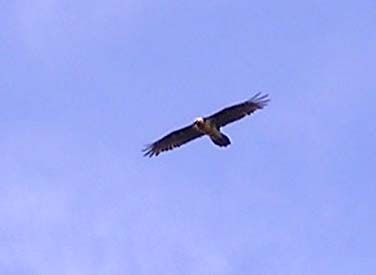
Lammergeier 19 June 2004 ~11 km W of Heimaihe, Qinghai |
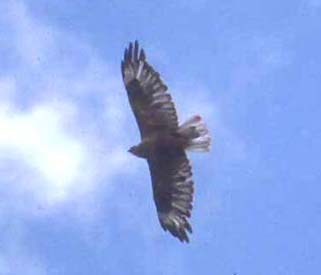
Upland Buzzard 24 June 2004 Rubber Mt. Pass |
| Japanese Sparrowhawk | Accipiter gularis | I saw a small Sharp-tailed Hawk-sized Accipiter in flight from the bus enroute to Wulingshan. This tentative i.d. is based primarily on that size; it would have been a lateish migrant on the date (7 June). |
| Eurasian Sparrowhawk | Accipiter nisus | A Cooper's Hawk-sized Accipiter at Huzu Bei Shan was surely this species; I missed others at Wulingshan and Bao Qo. |
| Eastern Marsh Harrier | Circus spilonotus | Reasonable common (8/day) at Xinghai Reserve. |
| Common Buzzard | Buteo buteo | Singles were noted on two days at Huzu Bei Shan; one was heavily harassed by a pair of unidentified corvids. |
| Upland Buzzard | Buteo hemilasius | The common raptor seen daily (up to 12/day) on the Qinghai Plateau; a pair with young had a nest in the arroyo we visited in the Caka Valley. This bird comes in a variety of color morphs and recalls North America's Ferruginous Hawk B. regalis to me. |
| Eurasian Kestrel | Falco tinnunculus | A widespread bird recorded at almost all locales from mountains to grasslands but only 2-3/day. |

female Amur Falcon 13 June 2004 at Xinghai Reserve |
| Amur Falcon | Falco amurensis ** | A rather common raptor over Manchurian grasslands and Xinghai Reserve; males of this highly dimorphic species were particularly stunning. |
| Eurasian Hobby | Falco subbuteo ** | Two were seen enroute to Wulingshan our first day and two more at Bao Qo in mountains north of Xining. This common Eurasian species was a long-delayed lifer for me. [But we would miss Saker F. cherrug that had been recorded on all previous tours.] |
| White-naped Crane | Grus vipio ** | This had been my 'most-wanted' bird pre-trip; that's all the fault of Peter Matthiessen's Birds of Heaven book! So it was with great relief that we eventually found a pair at the wettest marsh left at drought-ridden Xinghai Reserve. This is just a gorgeous creature; unfortunately the views were always fairly distant. |
| Black-necked Crane | Grus nigricollis ** | Although we had about 16 scattered around the south end of Qinghai Lake most were quite distant. It was a pair along the shores of Xiao Bei Hu that put on a real show during our two visits. During the first visit they were dive-bombed by a nest-protecting Common Tern — an amusing confrontation! The second time they were in perfect light with perfect reflections as they strode the shallow water. We also discovered another pair that day that were nesting; one adult was sitting on the barely emergent mound well out in the lake. |
| Red-crowned Crane | Grus japonensis ** | Another gorgeous crane; especially in flight. We had a total of five (2 pairs plus a youngster) in drying marshes at Xinghai Reserve. About 80% of the world's population nests in NE China. |
|
NORTH CHINA CRANES |
| White-breasted Waterhen | Amaurornis phoenicurus | I had one on lily pads at the Summer Palace while the group was off elsewhere; as it happened this was the only one of the trip. |
| Watercock | Gallicrex cinerea | One scoped at Xinghai Reserve was unexpected. |
| Ruddy-breasted Crake | Porzana fusca | One was seen well in the reeds at pond's edge at the Summer Palace in Beijing |
| Common Moorhen | Gallinula chloropus | A few daily at Xinghai Reserve. |
| Eurasian Coot | Fulica atra | Just a handful at Xiao Bei Hu and singles each day at Xinghai Reserve. |
| Great Bustard | Otis tarda ** | I had not expected to see this much-wanted species as it had not been on previous tours but we visited different grasslands in Manchuria this year. Here we saw at 14 birds and accidentally flushed an adult from its nest. We quickly gave it plenty of space to return. |
| Black-winged Stilt | Himantopus himantopus | Common and noisy at Xinghai Reserve (up to 80/day) but just 2 up on Qinghai Plateau. |
| Pied Avocet | Recurvirostra avosetta | Common and aggressive at Xinghai Reserve (50/day including many precocial young) but just 2 on Xiao Bei Hu on Qinghai Plateau. |
| Oriental Pratincole | Glareola maldivarum | Fairly common (up to 50/day) around Xinghai Reserve. |
| Little Ringed Plover | Charadrius dubius | Fairly common (up to 25/day) at Xinghai Reserve; a few were seen by others up on Qinghai Plateau. |
| Snowy Plover | Charadrius alexandrinus | The common nesting plover around Qinghai Lake and in Caka Valley (up to 43/day) with a handful previously at Xinghai Reserve. |
| Lesser (Mongolian) Sand-Plover | Charadrius mongolus | Six in alternate plumage in the small wetland at Caka (they apparently nest in the vicinity) and two more along shore of Xiao Bei Hu. |
| Greater Sand-Plover | Charadrius leschenaultii | Fine scope views of one in alternate plumage along the shore of Xiao Bei Hu that could be compared to C. mongolus. |
| Northern Lapwing | Vanellus vanellus | Rather common (up to 50/day) around Xinghai Reserve. |
| Gray-headed Lapwing | Vanellus cinereus ** | Reasonable common (up to 35/day) and aggressively defending nest sites along drying shores at Xinghai Reserve. |
| Black-tailed Godwit | Limosa limosa | Reasonable common (25/day) at one dried-up marsh on Xinghai Reserve where they must have been nesting among the grazing sheep and goats. |
| Eurasian Curlew | Numenius arquata | Common in the Manchurian grasslands and around Xinghai Reserve (up to 40/day). |
| Common Redshank | Tringa tetanus | The most widespread breeding shorebird; encountered most days on Qinghai Plateau and also fair numbers on Xinghai Reserve. |
| Marsh Sandpiper | Tringa stagnatilis | The few (1-6/day) at Xinghai Reserve were in alternate dress. |
| Common Greenshank | Tringa nebularia | Scarce lingering summerers at Xinghai (2) and Xiao Bei Hu (1). |
| Temminck’s Stint | Calidris temminckii | One with a damaged wing and still in basic plumage was late and lingering at the small wetland at Caka. Likely a rare vagrant at this date and latitude. |
| Red-necked Phalarope | Phalaropus lobatus | Even more unexpected than the Temminck's was this very late alternate-plumaged adult along the shores of Xiao Bei Hu adjacent to Qinghai Lake |

adult Brown-headed Gull in flight 18 June 2004 at Bird I., Qinghai Lake |

adult Pallas's Gull among Brown-headed Gulls 18 June 2004 at Bird I., Qinghai Lake |
| Pallas's (Great Black-headed) Gull | Larus ichthyaetus ** | Large and attractive black-headed adults were along the shores of Qinghai Lake (up to 100/day). Some frequented the edges of the gull colony at Bird Island; others foraged in the mouths of freshwater streams into Qinghai Lake. Almost all seen were full adults. |
| Brown-headed Gull | Larus brunnicephalus | This is the core nesting species at the Bird Island colony; hard to estimate numbers but perhaps a thousand or so. Paul says that numbers have been declining in recent years but there are still a lot. Also many scattered around the shores of Qinghai Lake. |
| Black-headed Gull | Larus ridibundus | Rather common (up to 40/day) at larger lakes around Xinghai Reserve but small numbers (5/day) up at Qinghai Lake vicinity. |
| Gull-billed Tern | Gelochelidon nilotica | Three scoped on the shores of a remaining Qinghai Lake. |
| Common Tern | Sterna hirundo | A widespread species found nesting at Xinghai in Manchuria (up to 20/day; occupied nests seen) and scattered about Qinghai Plateau (up to 80/day). Most entertaining was one dive-bombing the Black-necked Crane pair at Xiao Bei Hu. Close scope studies showed these were 'typical' Common Terns (race tibetana) rather than black-billed longipennis that breed in extreme NE China and then north into Siberia. |
| Little Tern | Sterna albifrons | Small numbers (max 20/day) at Xinghai Reserve. |
| Whiskered Tern | Chlidonias hybrida | A few at Xinghai Reserve (max 10/day) and one in alternate plumage along the shores of Xiao Bei Hu on Qinghai Plateau. |
| White-winged Tern | Chlidonias leucopterus | Conspicuous on a couple of lakes at Xinghai (up to 15/day) but three on Xiao Bei Hu (2 adults and a first-summer) were thought to be vagrants there. |
| [Rock Pigeon | Columba livia | Common in cities and towns; all appeared to be introduced birds and thus not counted as a number on my trip list.] |
| Hill Pigeon | Columba rupestris | The common wild pigeon of the Qinghai Plateau; seen daily (up to 40/day) and often in canyons. |
| Oriental Turtle Dove | Streptopelia orientalis | A few (max 4/day) were around Xinghai Reserve. |
| Spotted Dove | Streptopelia chinensis | Surprisingly scarce but I saw a couple from the bus in agricultural areas around Beijing. |
| Eurasian Collared Dove | Streptopelia decoacto | Often seen from the bus on trips through the agricultural areas outside Beijing; often perched on wires in small towns. |
| Large Hawk-Cuckoo | Cuculus sparveroides | Its call was a dominant sound at Wulingshan; I am familiar with the 'brain-fever' vocalization from other Asian trips. I didn't happen to see one this trip but some of the others did. |
| Indian Cuckoo | Cuculus micropterus ** | It was nice to get decent views of one in the open woods at the Summer Palace in Beijing. It responded nicely to tape. This is another common Asian species that I had not yet seen. |
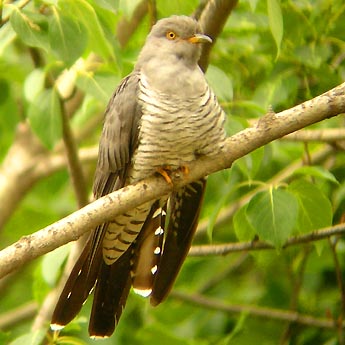
male Common Cuckoo 23 June 2004 in Huzu Bei Shan |

Hill Pigeon 18 June 2004 south of Qinghai Lake |
| Eurasian (Common) Cuckoo | Cuculus canorus | I was shocked at how common and easy to see this species was in north China. We saw it in open habitats virtually everywhere except the parks inside Beijing; it occurred in numbers from the Manchurian grasslands (up to 15/day; many flying or perched out in the open) to the high elevation forests at Huzu Bei Shan. The vast majority were males and they sat out on telephone lines! |
| Oriental Cuckoo | Cuculus optatus | Rather common in the mixed coniferous forests on mountains around Beijing (Wulingshan and Baideling); heard often in these habitats but only one seen. A male was watched calling steadily at Wulingshan one late afternoon. UPDATE: In 2006, the AOU, following Payne (2005), split C. saturatus ("Oriental Cuckoo") into 3 species: C. optatus Oriental Cuckoo (the breeder in n. China), C. saturatus Himalayan Cuckoo, and C. lepidus Sunda Cuckoo |
| Lesser Cuckoo | Cuculus poliocephalus ** | Regular at Wulingshan where heard every day; a couple seen in flight provided my first visual encounters with this rather widespread Asian species. |
| Little Owl | Athene noctua | Common in arid rocky habitats of the Qinghai Plateau; our group had 8 during the day in Caka Valley (roosting in holes in arroyo walls). |
| Short-eared Owl | Asio flammeus | One seen in flight over extensive grasslands north of Baichengzhi in Jilin Province. |
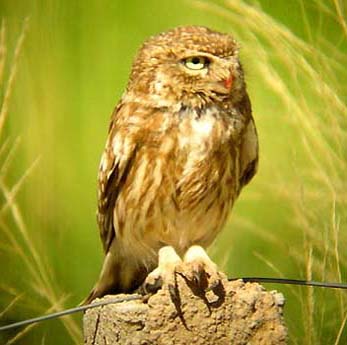
Little Owl 23 June 2004 in the Caka Valley |
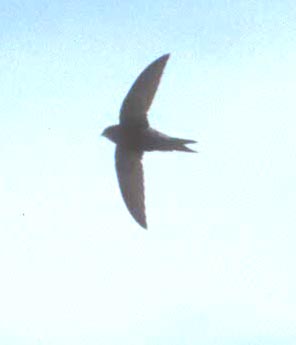
Common Swift 22 June 2004 at Qinghai Lake |
| Common Swift | Apus apus | The common swift at many spots including the Summer Palace in Beijing; Xinghai Reserve; and some spots around Qinghai Lake. Often 100+ at these locales. The race here in pekinensis; smaller and darker than European birds. |
| Fork-tailed Swift | Apus pacificus | Common and widespread throughout the Qinghai Plateau. Small groups were more typical than large ones. |
| Eurasian Hoopoe | Upupa epops | A couple at Xinghai Reserve, one carrying food. |
| Gray-capped Pygmy Woodpecker | Picoides canicapillus | A couple at Beijing's Summer Palace and two more at Baideling. |
| Great Spotted Woodpecker | Dendrocopos major | One at Beijing's Summer Palace was carrying food; others were recorded in Beijing in park adjacent to the Forbidden City and at Baideling. |
| Black Woodpecker | Dryocopus martius | A pair were in the 'lower canyon' at Huzu Bei Shan; we had very nice views of the male. |
| Gray-headed Woodpecker | Picus canus | One was watched at length in Beijing's Summer Palace; other birders had more elsewhere in e. China. |
| Tibetan Lark | Melanocorypha maxima ** | This largest 'Callendra'-like lark was seen most days on Qinghai Plateau -- including up at Rubber Mt. Pass at 12000' elev. |
| Mongolian Lark | Melanocorypha mongolica ** | This striking lark was common in the Manchurian grasslands but less so on the Qinghai Plateau (max 4/day). |
| Hume's Short-toed Lark | Callendrella acutirostris ** | Common on the Qinghai Plateau but rather inconspicuous. Best views were rather tame ones at Bird Island. |
| Asian Short-toed Lark | Callendrella cheleensis ** | Common in the Manchurian grasslands where males were conspicuous in song flights. I flushed a female off her nest by accident; she had 4 eggs on 12 June. |
| Eurasian Skylark | Alauda arvensis | Several heard singing over guesthouse at dry Xinghai Reserve. |
| Oriental Skylark | Alauda gulgula | Very common in open grasslands on Qinghai Plateau (often 100+/day). |
| Horned Lark | Alauda gulgula | Common in open country on Qinghai Plateau (up to 75/day); the birds here are very pale and grayish [race brandti]. |
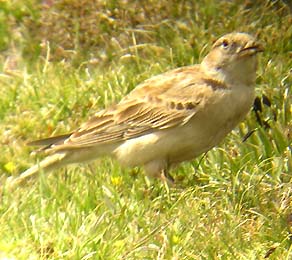
Tibetan Lark 19 June 2004 on Rubber Mt. Pass |
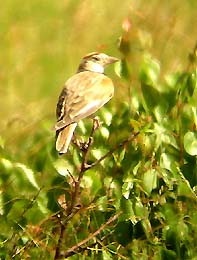
Mongolian Lark 12 June 2004 in Manchurian grasslands |
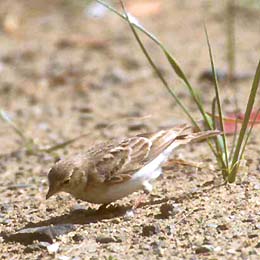
Hume's Short-toed Lark 18 June 2004 at Bird I., Qinghai Lake |
| Sand Martin [Bank Swallow] | Riparia riparia | We came upon large colonies (100+) on Xinghai Reserve and on Qinghai Plateau; recorded most days in Qinghai Province. |
| Eurasian Crag Martin | Hirundo rupestris | Scattered birds on Qinghai Plateau including a small nesting colony on Rubber Mt. Pass. |
| Barn Swallow | Hirundo rustica | Common and recorded daily in east and northeast China (up to 50/day); two in the Caka Valley were unusual (late migrants?). |
| Red-rumped Swallow | Hirundo daurica | Fairly common and widespread in east China; several were watching gathering mud for nests in a park in downtown Beijing. |
| Asian House Martin | Delichon dasypus | Moderate flocks (up to 40/day) encountered irregularly on the Qinghai Plateau. |
| Forest Wagtail | Dendroanthus indicus | One was foraging on the path and then heard singing from a tree branch in the woods at Baideling near the Great Wall. |
| White Wagtail | Motacilla alba | Widespread and recorded daily on Qinghai Plateau (up to 10/day; some feeding young). Another was seen at Baideling. The subspecies here is the white-faced leucopsis. |
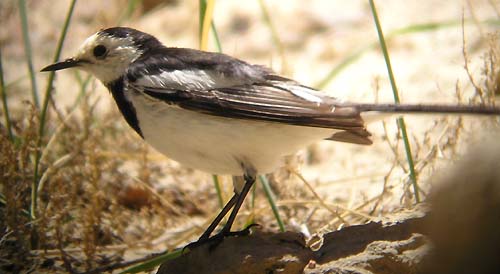
male leucopsis White Wagtail 20 June 2004 in Caka Valley |
| Citrine Wagtail | Motacilla citreola | A couple of males were watched on different days along streams running into Qinghai Lake. |
| Gray Wagtail | Motacilla cinerea | A couple at Baideling; others had one near Xining. |
| Richard's Pipit | Anthus richardi | This large pipit was recorded most days in grasslands -- both in Manchuria and on Qinghai Plateau -- but never in numbers (max 2/day). |
| Olive-backed Pipit | Anthus hodgsoni | Rather common near our camp in Huzu Bei Shan; males sang from trees and telephone lines much of the day. |
| Rosy Pipit | Anthus roseatus | A few at very high elevations -- Rubber Mt. and Huzu passes -- but most were in flight and decent views were hard to get. |
| Water Pipit | Anthus spinoletta ** | One was found along a stream as we ascended the Qinghai Plateau west of Xining. We stopped to look for it specifically and although Paul's 'old' spot had been bulldozed, he found another likely spot and voila! This was a long desired lifer since the split of American Pipit from this taxa. |
| Long-tailed Minivet | Pericrocotus ethologus | A half-dozen seen both days at Wulingshan. |

male Long-tailed Minivet 10 June 2004 at Wulingshan |

White-throated Dipper 22 June 2004 at Huzu Bei Shan |
| White-throated (Eurasian) Dipper | Cinclus cinclus ** | Several were along the rushing river at our Huzu Bei Shan campsite; I got nice photos of one while on my own. |
| Brown Dipper | Cinclus pallasii | An adult with two fledglings were along a rushing stream at the check-in station for Wulingshan. Others had a few more in Huzu Bei Shan. |
| Winter Wren | Troglodytes troglodytes | Fairly common in the thick woods at Wulingshan; others heard one singing at Huzu Bei Shan. |
| Robin Accentor | Prunella rubeculoides ** | Fair numbers (6-8/day) in scrubby canyons near the south shore of Qinghai Lake. |
| Rufous-breasted Accentor | Prunella strophiata | Scattered individuals were in mountains north of Xining and in foothills near Qinghai Lake. |
| Brown Accentor | Prunella fulvescens ** | A few seen almost daily on Qinghai Plateau in light scrub. |
| White-throated Rock-Thrush | Monticola gularis ** | One singing male was watching at long distance in scopes as he sat atop a high snag at Wulingshan each morning and afternoon. |
| Chestnut Thrush | Turdus rubrocanus ** | One singing on Huzu Pass responded to a tape and perched briefly; others were seen or heard each day at Huzu Bei Shan. I watched one work the leaf litter like a towhee one late afternoon near our camp. |
| Kessler's Thrush | Turdus kessleri ** | This very lovely thrush was encountered in several montane locales in north Qinghai: I saw it at Bao Qo (north of Xining) and several around Huzu Bei Shan; others had it elsewhere. |
| Gray-sided Thrush | Turdus feae ** | Several easily heard but hard to see around our lodgings at Wulingshan -- but it did use tree tops and power lines at dawn and dusk. |
| Chinese Thrush | Turdus mupinensis ** | Another difficult species to see that was eventually scoped singing from tree tops and distant power lines at Wulingshan; another heard and then seen at Huzu Bei Shan in Qinghai. |
| Goldcrest | Regulus regulus | At least one in the fir forest at Bao Qo (north of Xining). I heard it (e.g. sounds like Golden-crowned Kinglet) but at first no one believed me [see Crested Tit-Warbler]. So I tracked it down and showed it to the group. I thought I heard more at Huzu Bei Shan but did not see it there. |
| White-browed Chinese-Warbler | Rhopophilus pekinensis ** | One seen and several more heard in response to tapes at Baideling. This species lives in thick chaparral-like undergrowth and was very hard to see. When finally viewed it proved to a big long-tailed beast that recalls Turdoidesbabblers. Surely it is a babbler and not a Sylvid? Perhaps no one has studied this Chinese endemic? |
| Southern Spotted Bush-Warbler | Bradypterus thoracicus przevalskii ** | After lots of work with Paul's tape at various Qinghai locales we finally had superb views in the 'lower canyon' at Huzu Bei Shan. The next morning he was still singing and viewable without a tape!; otherwise a real skulker. On an earlier day we had one just a few feet from all of us surrounding it is low thickets but only Paul saw it. This is a split (primarily on vocalizations) from Northern Spotted Bush-Warbler B. (t) davidi (e.g., Round & Loskot 1994) We also tried for it several places near Beijing but without any response to tapes. |
| Pallas's (Rusty-rumped) Warbler | Locustella certhiola ** | Very fine views of one working the mud-edge within reeds at Beijing's Summer Palace were obtained through scopes. It even took a bath. We also likely had Lancolated Warbler L. lanceolatawhen flushed in grasslands north of Baichengzhi but the flight views were too poor to be sure. Another unidentified Locustellawas flushed in reeds at Xinghai Reserve. These birds are real skulkers. |
| Oriental Reed-Warbler | Acrocephalus orientalis | Common and very noisy in reeds and adjacent weeping willows at the Summer Palace in Beijing. We had great views. A few were also singing in reeds at Xinghai Reserve but the next species was the dominant one there. |
| Black-browed Reed-Warbler | Acrocephalus bistrigiceps ** | Common in reeds at Xinghai Reserve where many good views obtained; also good views of some at Beijing's Summer Palace (including a likely late migrant that was in bushes instead of reeds). |
| Manchurian Reed-Warbler | Acrocephalus tangorum ** | One studied at length (but views usually rather brief each time) in reeds at Xinghai Reserve. We got good comparison of both plumage and song next to Black-browed. I was well-prepared for this bird as I brought two i.d. papers (Alström et al. 1991, Leader & Lewthwaite 1996) with me on the trip. It is also now well established that this is a good species (split from Paddyfield A. agricola) and clearly different from Black-browed (they breed in the same marshes at Xinghai and have different songs). Some older literature shows them all lumped together. |
| White-browed Tit-Warbler | Leptopoecile sophiae ** | This genus is nearly endemic to China (this species gets to Bhutan) but together the two tit-warblers are highly prized finds. After a fair bit of frustration we all got to see a pair of these in dwarf vegetation near treeline above Qinghai Lake. Both were carrying food so they had a nest nearby. Paul heard others in the Huzu Bei Shan vicinity. Dickinson (2003) places the two tit-warblers in the Aegithalidae (Long-tailed Tits), a proposal that makes a lot of sense to me after hearing the calls and seeing the nest of the following species. |
| Crested Tit-Warbler | Leptopoecile elegans ** | A pair were seen and then relocated several times (often by their goldcrest-like calls that are subtly different) in a patch of firs at Bao Qo in mountains north of Xining. We eventually discovered they were building a nest 50 feet up in one conifer! We watched them for some time; the breeding behavior and nest of this enigmatic species is little known. For tiny birds (size of bushtits) they are very colorful with a silky gray crest. |
| Dusky Warbler | Phylloscopus fuscatus | A late migrant was heard 'ticking' and then nicely seen in bushes at Beijing's Summer Palace on 11 June. Breeders (race wiegoldi) were encountered (1-2/day) in dwarf scrub on ridges above Qinghai Lake. |
| Tickell's Warbler | Phylloscopus affinis | Rather common in scrubby habitat on Qinghai Plateau. |
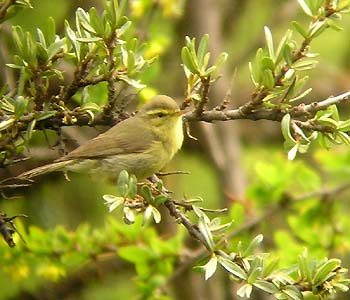
Tickell's Warbler 22 June 2004 on Huzu Pass |
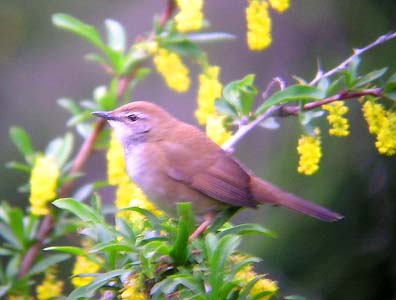
Southern Spotted Bush-Warbler 24 June 2004 at Huzu Bei Shan |
| Yellow-streaked Warbler | Phylloscopus armandii ** | Several encountered at Wulingshan and north of Xining and at Huzu Bei Shan; most were singing. I never did learn this song (I learned most of the other Phylloscopussongs by trip's end) but got several good views. It recalls North America's Orange-crowned Warbler to me in general coloration and should not be an i.d. contender for vagrant Dusky Warblers to California (e.g. the two Dusky Warblers I've seen in California were classic warm buff birds). |
| Buff-barred Warbler | Phylloscopus pulcher | One seen at Huzu Bei Shan when Paul played back its very distinctive song. |
| Gansu Leaf-Warbler | Phylloscopus kansuensis ** | Rather common (10+/day) at both sites we visited in mountains north of Xining: Bao Qo and our campsite in Huzu Bei Shan. This is a recent split in the Pallas's/Lemon-rumped Warbler group. Its distinctive song was initially discovered by Paul Lehman -- and more evidence of taxonomic status was uncovered by Paul Holt -- both of whom got rather short shrift in the published paper (Alstrom et al. 1994). The paper suggested the English name of Gansu Leaf-Warbler despite the fact that virtually all of the known populations are in Qinghai Province rather than adjacent Gansu. The reasons given are (a) Gansu is a translation of the latin name (kansuensis) and (b) if it were called 'Qinghai Leaf-Warbler' most English speakers would mispronounce it! What a reason! What about education? We English speakers can be taught that Qinghai is pronounced "ching-hi." To top it all off: the authors making these pronouncements are Swedes for whom English is a second language! By everything that is dear and right, this species should be called 'Qinghai Leaf-Warbler'! Or even Lehman's Qinghai Leaf-Warbler! |
| Chinese Leaf-Warbler | Phylloscopus yunnanensis ** | Common and noisy at Wulingshan; males sat atop spiky spruces and 'chip-chip-chipped' all daylong (interspersed with other distinctive call notes). This is a recent split from the Pallas's/Lemon-rumped group; as noted on the introductory trip report it was initially named sichuanensis (Alstrom et al. 2000) but recent evidence shows that the older yunnanensis has priority. |
| Hume's Warbler | Phylloscopus humei | Common in the mountain forests at Wulingshan (where we found a nest with young and many adults were carrying food) and Bao Qo (north of Xining) but a bit less so at Huzu Bei Shan where the next species dominates. |
| Greenish Warbler | Phylloscopus trochiloides | Common and noisy all daylong in the spruce/juniper/birch forests around our campsite at Huzu Bei Shan. The race here is P.t.obscurus. |
| Large-billed Leaf-Warbler | Phylloscopus magnirostris ** | A singing bird was taped-in for views at Wulingshan (a significant breeding range extension found a few years back by Paul Holt) and another was seen well at Huzu Bei Shan (more heard daily there). This is a big Phyllosc that recalls a big vireo to me. |
| Eastern Crowned Warbler | Phylloscopus coronatus ** | One was nicely seen at Baideling after it responded to Paul's tape. |
| Blyth's Leaf Warbler | Phylloscopus reguloides | Fairly common (up to 6/day) in some montane forests: Wulingshan and Baideling and Bao Qo but heard only (and just by Paul) at Huzu Bei Shan. |
 23 June 2004 at Huzu Bei Shan |
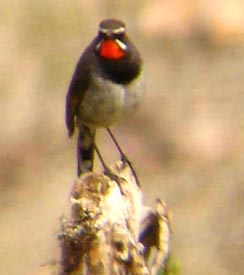
19 June 2004 west of Heimaihe |
| Siberian Rubythroat | Luscinia calliope | Heard regularly at Huzu Bei Shan but seen only once in response to tapes. At that time it was exceedingly curious; sang persistently; and permitted some nice photos. | |
| White-tailed Rubythroat | Luscinia pectoralis | A female and then a male were seen in dwarf alpine scrub on a ridge above Qinghai Lake. Both responded to tapes; the male eventually sat out in the open on a fence post for prolonged singing bouts (and distant photos). | |
| Siberian Blue Robin | Luscinia cyane ** | Common at Wulingshan (by vocalizations) but extremely hard to see well. Numerous efforts with tapes and different individuals were needed before most of the group had a decent view of one or another. | |
| Orange-flanked Bush Robin [Red-flanked Bluetail] | Tarsiger cyanurus | Regular in forest-edge scrub at Huzu Bei Shan but rather hard to see; I did see a pair both days that any time was spent in pursuit. | |
| Ala Shan Redstart | Phoenicurus alaschanicus ** | This rare endemic was found in 'Paul's Canyon' along the south shore of Qinghai Lake. One male was singing on territory and did several 'circuits' of the patch of scrub and low trees; David Fisher & I were able to obtain some dynamite photos despite backlit conditions. One of the major highlight birds of the trip; a photo is on my 'China redstarts' page. | |
| Black Redstart | Phoenicurus ochruros | The widespread and conspicuous redstart on the Qinghai Plateau (typically 30-40/day). Frequented open country and ruins of adobe buildings; we found nests in crevices on rockcuts through various road passes. Photos on my 'China redstarts' page. | |
| Hodgson’s Redstart | Phoenicurus hodgsoni ** | A male and female foraged each afternoon along the rushing river next to our camp at Huzu Bei Shan. Photos on my 'China redstarts' page. | |
| White-throated Redstart | Phoenicurus schisticeps ** | Reasonable common n montane scrub adjacent to forest at Bao Qo (north of Xining) and Huzu Bei Shan (also north of Xining). This is a very striking species (especially the gorgeous male); pairs were often seen carrying food to hidden nests. Photos of the male on my 'China redstarts' page. | |
| Daurian Redstart | Phoenicurus auroreus ** | A rather common and conspicuous redstart in montane forests at Wulingshan and Baideling (both in east China) and at Bao Qo (north Qinghai Province). Singing males often sat atop the highest snag or other perch available (and that could be power lines). Quite a pretty little bird; photos on my 'China redstarts' page. | |
| White-winged (Güldenstädt's) Redstart | Phoenicurus erythrogaster ** | Scarce and hard-to-find; we found only 1-2/day in rocky rubble or little meadows at very high elevation on Rubber Mt. Pass (12,500'). This is a big and bold redstart. Photos on my 'China redstarts' page. | |
| Blue-fronted Redstart | Phoenicurus frontalis | This small redstart was found in alpine scrub at 'Paul's Canyon' near Qinghai Lake and on Huzu Pass. At the former we walked right through a territory with very defensive male and female; a brief search located a fledgling they were actively feeding. Photos on my 'China redstarts' page. | |
| White-capped Water Redstart | Chaimarrornis leucocephalus | Rather easily found along the rushing rivers at Huzu Bei Shan and at Bao Qo (both inmountains north of Xining). Big and bold; photos on my 'China redstarts' page. | |
| Plumbeous Redstart | Rhyacornis fuliginosus | A female was spotted along the rushing stream next to our camp at Huzu Bei Shan; a photo from Kashmir is on my 'China redstarts' page. | |
| White-bellied Redstart | Hodgsonius phaenicuroides ** | Rather common in the forest undergrowth at Wulingshan but hard to see. Nice views available after one spent enough time; a poor photo is on my 'China redstarts' page. | |
| Siberian Stonechat | Saxicola mauri | Three (two males and a female) were seen in dwarf scrub near Qinghai Lake. The race here (przevalskii) is among the 'Siberian Stonechat' group that was split from Common Stonechat S. torquata in the most recent taxonomic review (Urquhart & Bowley 2003). | |
| Pied Wheatear | Oenanthe deserti | A couple of pairs were in dry rocky cliffs near a neighborhood on the north side of Xining. | |
| Desert Wheatear | Oenanthe deserti | An uncommon but fairly regular species in drier portions of the Qinghai Plateau including the Caka Valley and the sand dunes by Qinghai Lake. | |
| Isabelline Wheatear | Oenanthe isabellina | Common and widespread in grasslands of the Qinghai Plateau (up to 20/day); several recently fledged juvs also found. | |
| Yellow-rumped Flycatcher | Ficedula zanthopygia ** | We heard or saw about a dozen singing males in woods at Baideling; David Fisher got some marvelous digiscoped shots. This is a glowing and quite lovely little bird. | |
| Narcissus Flycatcher [Elisa's or Chinese Narcissus Flycatcher] | Ficedula narcissina ** | Uncommon but regular in the forests at Wulingshan. These are of the subspecies elisae that should be considered a separate species from the vocally different nominate birds in Japan. See page two of the trip report for details on why "Beijing Flycatcher" does not exist. We saw two "Beijing Flycatchers" the same day we saw two male Elisa's; it is apparent that "Beijing" is simply the first-summer plumage of Elisa's Flycatcher. | |
| Slaty-backed Flycatcher | Ficedula hodgsonii ** | One singing male was finally seen at Huzu Bei Shan for the final lifer of the trip. It was the only one heard the entire three days camping there. It proved to be just a beautiful little bird. | |
| Blue-and-white Flycatcher | Cyanoptila cyanomelana | One singing male was tracked down at Wulingshan. It was scoped as it sang for the top of a snag well down a forested valley. It is quite striking in plumage and has a vaguely 'Canyon Wren-like' song. | |
| Plain Laughingthrush | Garrulax davidi ** | It proved to be quite a problem to see this species. We heard several at Baideling but only David Fisher saw one there. We heard more on Huzu Pass but the only one discovered (by Arnie Moorhouse) was sitting tight on a nest in the middle of a thicket; this permitted only marginal views of an eye here and a bill there. Finally we saw a small group of 4 in scrub at a canyon mouth in Huzu Bei Shan. | |
| Elliot's Laughingthrush | Garrulax elliotii ** | One was seen at Bao Qo (montane scrub north of Xining) and then a few were encountered daily at Huzu Bei Shan. These birds move and congregate together; they also cackle in unison. They remind me of certain African Babblers (e.g. Northern Pied Babblers) in their behavior. | |
| Chinese Penduline-Tit | Remiz consolbrinus ** | I found the first one (a female) in a tiny bit of vegetation in dunes at a drying lake edge in Xinghai Reserve; a pair were located the next day in a larger grassy marsh on the Reserve. | |
| Long-tailed Tit | Aegithalos caudatus | Small parties at Wulingshan and Baideling but both groups were fairly elusive. | |
| Marsh Tit | Parus palustris | A pair at Wulingshan were nicely viewed; Paul heard another a Baideling. Arnie and I also tracked down tit songs in a public park in downtown Beijing and found that someone had a half-dozen Marsh Tits in tiny bamboo cages. |

Yellow-bellied Tit 9 June 1004 at Wulingshan |

Songar Tit 9 June 2004 at Wulingshan |
| Songar Tit | Parus songarus ** | Common in mountains of north China: Wulingshan, Baideling (seen feeding young), Bao Qo, and Huzu Bei Shan. Some authorities consider this is a race of Willow Tit P. montanus, but both the most recent family monograph (Harrap & Quinn (2000) and the most recent world checklist (Dickinson 2003) split it, so I follow suit here. |
| White-browed Tit | Parus superciliosus ** | This Chinese endemic was heard or seen by others in scrubby canyons south of Qinghai Lake by others. I thought I'd missed this one but one was seen flying in and out of a nest hole right in a road-cut on Huzu Pass during the final days of the trip! |
| Rufous-vented Tit | Parus rubidiventris ** | One was in a mixed flock inside a fir forest patch at Bao Qo (north of Xining) but it could be that I was the only one to see it. It reminded me very much of the related Rufous-naped Tit P. rufonuchalus [also called Black-breasted or Simla Black Tit] that I photographed years ago in Kashmir [photo on my web site]. |
| Yellow-bellied Tit | Parus venustulus ** | Another fine Chinese endemic encountered at Wulingshan (up to 5/day including juvs) and Baideling (8). |
| Grey-crested Tit | Parus dichrous ** | A few heard daily at Huzu Bei Shan but only one tracked down in a mixed flock for good views. |
| Great Tit | Parus major | Common in some montane forests — Baideling (watched pairs feed young) and Bao Qo — but scarce in others (Wulingshan). The race here is the gray minor. |
| Hume's Groundpecker | Pseudopodaces humilis ** | Long included near ground-jays in the Corvids the recent biochemical evidence is that this wonderful bird evolved from tits (James et al. 2003; see also Londei 200). James et al. (2003) consider it most closely related to Great Tit. However after reviewing the evidence I think it may best to consider this as a monotypic family of its own. It is clearly not the world's smallest jay — and it seems reasonable that it should not now be thought of as the world's biggest tit. While its parid ancestry now seems well established it is a quite distinctive, long-legged, ground-feeding passerine endemic to the Tibetan-Qinghai Plateau. It is quite common there in open country (grasslands and rocky road cuts; we typically saw up to 25/day). Many were carrying food as they foraged in the open; we located several nest burrows built in dirt cliff-faces or rocky crevices. |
| Eurasian Nuthatch | Sitta europaea | Fairly common (up to 8/day) at Wulingshan. The race here is amurensis. |
| Chinese Nuthatch | Sitta villosa ** | This endemic was found at Wulingshan (6 birds) where it responded well to tapes. Three more were in the forests at Bao Qo (north of Xining) that we visited especially in hopes of finding the 'other' White-cheeked Nuthatch. It appears Paul was misled as to the nuthatch there (he had never previously visited the site). |
| White-cheeked Nuthatch | Sitta leucopsis ** | Noisy and heard daily at Huzu Bei Shan but numbers actually small (just 2-3 max per day). This the race przevalskii ['Przevalski's Nuthatch]. On our final day in the 'lower canyon' we actually discovered an active nest hole. |
| Wallcreeper | Tichodroma muraria | One foraged on steep canyon walls in 'Paul's Canyon' south of Qinghai Lake. It was always on the move and thus digiscoped shots were very poor (sigh...). Always a treat to watch a Wallcreeper! |
| Eurasian Treecreeper | Certhia familliaris | A couple were in the coniferous grove at Bao Qo; several were seen or heard daily in the forests at Huzu Bei Shan. The race here is bianchii. |
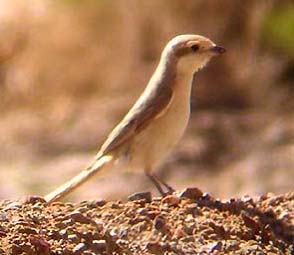
Rufous-tailed Shrike 21 June 2004 at Caka |
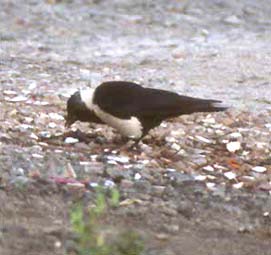
Daurian Jackdaw 17 June 2004 west of Xining |
| Black-naped Oriole | Oriolus chinensis | A male was watched singing at Baideling. Others saw a couple more elsewhere in e. China. |
| Long-tailed Shrike | Lanius schach | A couple were perched alongside the freeway enroute to the Xining airport to start the trip home; the last species recorded on the trip. |
| Rufous-tailed (Isabelline) Shrike | Lanius isabellinus | A couple were at the edge of the small wetland that was adjacent to the drying salt lake at Caka. |
| Brown Shrike | Lanius cristatus | A few were scattered about Xinghai Reserve and noted from the jeeps. |
| Gray-backed Shrike | Lanius tephronotus | The regular shrike up on the Qinghai Plateau (including open areas in the mountains) but not common (max 2-3/day). |
| Chinese Gray Shrike | Lanius spenocercus ** | A couple were seen every day in Xinghai Reserve were they foraged over open country with long flights between perches. |
| Black Drongo | Dicrurus macrocercus | Rather common in the open agricultural land around Beijing; mostly seen from the bus. One seen by others at high elevation in Caka was considered out-of-place. |
| Hair-crested Drongo | Dicrurus hottentotus | A drongo in flight over the wooded hills at Baideling seemed likely this species on range & habitat; it was seen only by David and I and did not have the jizz of Black Drongo. |
| Red-billed Blue Magpie | Urocissa erythrorhyncha | Three were in a Beijing city park adjacent to the Forbidden City; more were in open country near our montane forest a at Bao Qo north of Xining. This is a dramatic bird and some voted it "bird of the trip" without regard for its wide range and overall abundance. |
| Azure-winged Magpie | Cyanopica cyanus ** | Rather common in city parks in Beijing and scattered about the countryside of e. China; also some at Bao Qo north of Xining. |
| Eurasian Jay | Garrulus glandarius | A couple were in the 'lower canyon' at Huzu Bei Shan our last day there. |
| Common (Eurasian) Magpie | Pica pica | Common in open country of east China and a dozen or more were recorded daily. Also present around Xining and up towards the Qinghai Plateau but none were on the high elevation Plateau itself. |
| Mongolian Ground-Jay | Podoces hendersoni ** | A family party of four was finally spotted from the bus in Caka Valley after several hours of intensive search. We then watched them forage on the ground; visit a small watertank; and view the scenery (and us) with small ridgetops. This had been one of my 'most-wanted' birds of the trip. |
| Spotted Nutcracker | Nucifraga caryocatactes | Several were seen or heard in the montane forests at Wulingshan. |
| Red-billed Chough | Pyrrhocorax pyrrhocorax ** | Rather common and recorded daily (max 10/day) in open country on the Qinghai Plateau. |
| Daurian Jackdaw | Corvus dauuricus ** | Reasonable common (15/day) in its rather narrow elevational range between Xining and the Qinghai Plateau. |
| Rook | Corvus frugilegus | A few (4) were seen around Bao Qo (north of Xining); others had another at Huzu Bei Shan. |
| Carrion Crow | Corvus corone | Recorded for sure on just a single day at Xinghai Reserve (5) but a pair of corvids relentlessly dive-bombing a Buzzard at Huzu Bei Shan were either this species or Rooks. |
| Large-billed Crow | Corvus macrorhynchus | Widespread in the lowlands --both around Beijing and around Xining -- and recorded almost daily. Some were up in the forests at Wulingshan; an adult and just-fledged youngster were in a city park in downtown Beijing. |
| White-cheeked Starling | Sturnus cineraceus ** | Small flocks were reasonably common in agricultural land around Beijing but I didn't get good looks until were found a flock at Beijing's Summer Palace. |
| [Crested Myna | Acridotheres cristatellus | Several posed for good views at the Summer Palace in Beijing. The known range (south China through southeast Asia) does not extend this far north. Paul Holt wasn't sure if a range extension was underway; it seemed best to treat the Beijing birds as introduced non-natives. Thus I do not include in the totals here nor is this species yet on my world list.] |
| Eurasian Tree Sparrow | Passer montanus | Common and widespread at all elevations in open country and around habitation. The only days it was not recorded were the camping days at Huzu Bei Shan; the day in the forest at Wulingshan; and another forest day at Bao Qo. |
| Rock Petronia (Rock Sparrow) | Petronia petronia | Regular in small numbers (max 5/day) in open dry country on the Qinghai Plateau. They especially liked arid canyons. |
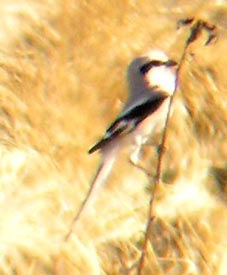
Chinese Gray Shrike 12 June 2004 in Xinghai Reserve |
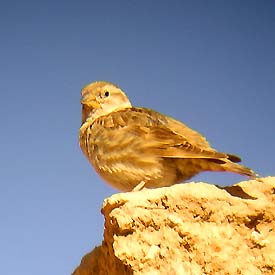
Rock Petronia 20 June 2004 in Caka Valley |
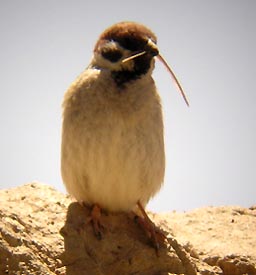
Eurasian Tree Sparrow 20 June 2004 in Caka Valley |
| Blanford's (Plain-backed) Snowfinch | Montifringilla blanfordi ** | The only spot we saw this species was in the arid Caka Valley. On both days we had adults carrying food and feeding fledglings right next to the bus. Very cool! |
| White-rumped Snowfinch | Montifringilla taczanowskii ** | In one area along the south shore of Qinghai Lake we found what proved to be 8 adults feeding 9 babies; we hardly had any others the whole trip. |
| Small (Pere David's) Snowfinch | Montifringilla davidiana ** | A few (max 8/day) were in grasslands along the south shore of Qinghai Lake. |
| Tibetan Snowfinch | Montifringilla davidiana ** | Up in 'Paul's Canyon' above the south shore of Qinghai Lake we discovered a pair carrying food into a nest burrow at the base of a broken-off log high on the cliff's edge. |
| White-winged (Eurasian) Snowfinch | Montifringilla nivalis | We located several (max 5/day) each time we went over Rubber Mt. Pass. Here above treeline the snowfinches were breeding; one day we found an active nest burrow to which the adults were regularly carrying food. |
| Rufous-necked Snowfinch | Montifringilla ruficollis ** | A few scattered over three days along the south shore of Qinghai Lake. |
| Gray-capped Greenfinch | Carduelis sinica | A pair at Baideling was it. |
| Twite | Carduelis flavirostris | Twites were very common at high elevation up on the Qinghai Plateau (up to 80/day). We were looking through flocks of Twites in search of rosefinches and snowfinches. |
| Plain Mountain-Finch | Leucostricte nemoricola ** | A very few (max 6/day) were scoped in rocky talus or meadow edge at very high elevation above treeline on Rubber Mt. Pass (12500'). |
| Pink-tailed Bunting | Urocynchramus pylzowi ** | Two pairs were found in alpine scrub on a ridge west of Heimaihe; males were singing and tape-recorded by Paul. I got a few nice photos; see page one of trip report. As discussed there the recent evidence is that this is a relict lineage not closely related to either buntings or rosefinches. |
| Common Rosefinch | Carpodacus erythrinus | A few were around Huzu Bei Shan; a nice male was scoped at Bao Qo. |
| Beautiful Rosefinch | Carpodacus pulcherrimus ** | This is a very misleading name. This is basically a House Finch up at high elevation: reasonably common (up to 10/day) in alpine scrub above Qinghai Lake. No big deal at all. |
| White-browed Rosefinch | Carpodacus thura ** | Much more striking than the last species; reasonably common around our camp at Huzu Bei Shan. This species has a remarkably goat-like bleat for its call: easily learned. |
| Streaked Rosefinch | Carpodacus rubiciloides ** | This and the following species are larger rosefinches; they are closely related and have been lumped by others. This is the one on the ridges above Qinghai Lake. I was able to study them and the next species for some preliminary i.d. thoughts. |
| Great Rosefinch | Carpodacus rubicilla ** | A small party (adult males and a few female-types) were foraging on an arid cliff-face down an arroyo in the dry Caka Valley. Essentially the same size and coloration as prior species but I have some tentative i.d. notes on separating the females. |
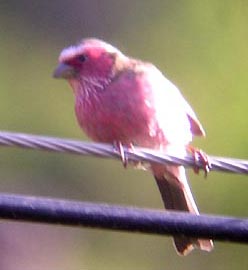
White-browed Rosefinch 22 June 2004 at Huzu Pass |
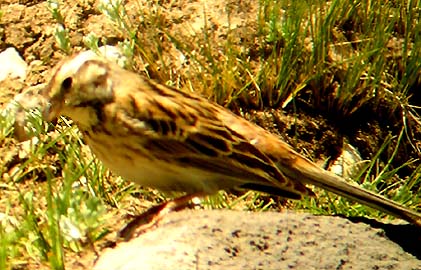
female Pine Bunting 18 June 2004 south of Qinghai Lake |
| Red Crossbill | Loxia curvirostra | Small flocks (15-35/day) were in forests north of Xining: at Bao Qo and our campsite at Huzu Bei Shan. They did not sound like the standard 'type-2' crossbills that invade Monterey County from time to time. Who knows which sibling species these are? |
| Gray-headed Bullfinch | Pyrrhula erythaca ** | A pair watched in mixed coniferous/birch forest at Bao Qo (north of Xining) and others had more around Huzu Bei Shan. |
| Yellow-billed Grosbeak | Eophona migratoria ** | A mixed age-and-sex party of six were an unexpected treat in the light woodland at Beijing's Summer Palace. |
| White-winged Grosbeak | Mycerobas carnipes ** | A pair were watched in flight — and then briefly perched for those fast enough with the scope— in the 'lower canyon' at Huzu Bei Shan. |
| Pine Bunting | Emberiza leucocephalos ** | One female of the loca race fronto was foraging in the grass south of Qinghai Lake. This was unexpected as this subspecies is scarce. |
| Godlewski's Bunting | Emberiza godlewskii ** | Rather common in montane forests from Wulingshan to Baideling to Bao Qo. More were heard and seen around our camp at Huzu Bei Shan. |
| Jankowski's Bunting | Emberiza jankowskii ** | For me the rarest and most interesting bird of the trip was a male singing in extensive short-grass prairie north of Baichengzhi on the Manchurian plain [photos on page two of the trip report]. This is an endangered species and rapidly declining. |
| Yellow-throated Bunting | Emberiza elegans ** | A pair were found (after multiple attempts by tape) along the road down from Wulingshan in a little alder grove. Truly a spectacularly patterned bunting! |
| Black-faced Bunting | Emberiza spodocephala | A singing male of the local race sordida was scoped in trees edging a planted field west of Xining as we ascended the Qinghai Plateau. |
| Pallas's Reed-Bunting | Emberiza pallasi ** | We flushed one male in the Manchurian grasslands north of Baichengzhi; I got a decent look at it in flight. I was well-prepared for this species after spending hours sorting out the reed-bunting on Attu back in 1980 [that was a female Common Reed-Bunting E. schoeniclus]. |

Godlewski's Bunting 10 June 2004 at Wulingshan, Hebei Province |
Birds recorded by others on our trip but which I missed: Cattle Egret Bubulcus ibis (others saw some from bus near Beijing), Pied Harrier Circus melanoleucos * (Paul scoped one at long distance at Xinghai but it disappeared before I got on it), Gray-faced Buzzard Butastur indicus (one spotted by Arnie from the bus as we left Wulingshan was seen by some but disappeared quickly), Northern Goshawk Accipiter gentilis (Paul had one at Huzu Bei Shan), Eurasian Oystercatcher Haematopus ostralegus (some of the group had one at Xinghai), Tawny Owl Strix aluco * (one was heard and seen by some at Wulingshan in very late afternoon), Common Kingfisher Alcedo atthis (some had one at Summer Palace), Yellow Wagtail Motacilla flava (Paul heard one at Xinghai Reserve), Asian Stubtail Urosphena squameiceps * (Paul heard one at Baideling), Vinous-throated Parrotbill Paradoxornis webbianus * (Paul heard it and had a quick glimpse at Baideling), Chestnut-flanked White-eye Zosterops erythropterus * (we heard some at Baideling but never got views), Meadow Bunting Emberiza cioides * (the rest of the group was looking at one when I found the Chinese Penduline-Tit and by the time all was sorted out, the bunting was gone).
MAMMALS
| Common Barking-Deer (Muntjac) | Muntiacus muntjak | What was possibly this or a related species was heard only at Wulingshan. |
| Vole sp. | genus ? | Several were seen scurrying in meadows near our campsite at Huzu Bei Shan. |
| Plateau (Black-lipped) Pika | Ochotona curzoniae | Common in grasslands of the Qinghai Plateau where it is considered a 'keystone' species (Chien-Hsun & Smith 1996). Paul had a field guide that covered some of the Chinese mammals and David was able to confirm which species we had by details of ears and lips. |
| Midday Gerbil | Meriones meridianus | A few were seen near their burrows in Xinghai Reserve. I used my photos to sort this out: There are two primary candidates in north China that live in sandy conditions: Midday Gerbil and Mongolian Gerbil M. unguiculatus. The latter is the ancestor of all the pet gerbils. According to an on-line paper by the National Gerbil Society (in Britain) by Julian Barker the two species are quite similar in appearance but "the main differences are that the Midday Gerbil has light claws instead of the almost black claws of the Mongolian Gerbil, and their belly fur is clearly white. Wild Mongolian Gerbils have grayish belly fur which has been eliminated by selective breeding from the domestic gerbils we have now." The photo (below) clearly shows a white belly and light (not blackish) claws; ergo, meet the Midday Gerbil! |
| [Cape Hare | Lepus capensis | Others had several hares in open grasslands of Manchuria; we presume they were this species but see next entry.] |
| Woolly Hare | Lepus oiostolus | We had hares daily on the Qinghai Plateau; it seems likely that some or all were this species that is endemic to the Tibetain-Qinghai Plateau. There is even a proposed race (tsaidamensis) from "southwest of Koko-Nor" [=Qinghai Lake]. An on-line search suggests there are 6-7 species of Lepus hares in China. We may have been within the range of Chinese Hare L. sinensis in east China; within the range of Manchurian Hare L. mandschuricus in Manchuria (or maybe L. tolai that is said to be in northeast China?). I'm not sure that I ever saw anything that wasn't Woolly Hare but I didn't see the Manchurian beasts. For what it is worth there is a web page on Snow Leopard that lists Woolly Hare along with the Himalayan Marmot and pikas as regular small prey for the leopard. |
| Pere David's Rock Squirrel | Sciurotamis davidianus | Seen daily at Wulingshan; also (presumably this squirrel) at Baideling. |
| Siberian Chipmunk | Eutamius sibiricus | Several daily in the woods at Wulingshan. This is the only chipmunk in the Old World. The rest of the world's species are centered around California [see my chipmunk web page]. |
| Daurian Ground-Squirrel | Citellus dauuricus | A couple were seen in Xinghai Reserve. |
| Himalayan Marmot | Marmota himalayana | A few were located near their burrows almost daily up on the Qinghai Plateau and in the mountains (e.g. Huzu Bei Shan). Except for a marmot in the Alps I think this now completes my world list for Marmota. |
| Tibetan Fox | Vulpes ferrilata | Several were seen on the Qinghai Plateau, often near their burrows. One pair was watching frolicking with three youngsters. |
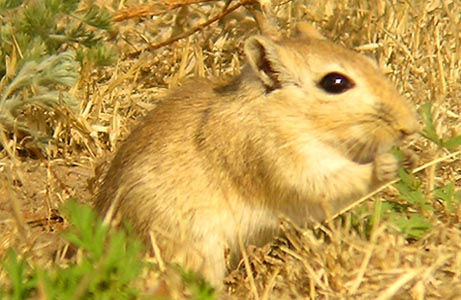
Midday Gerbil 13 June 1004 in Xinghai Reserve |
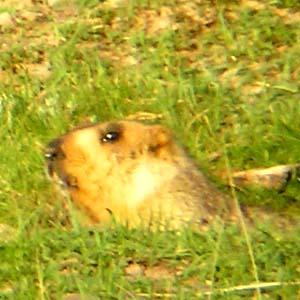
Himalayan Marmot 18 June 2004 near Qinghai Lake |
HERPS
| Qinghai Toad-headed Lizard | Phrynocephalus vlangallii | Two vigorously interacting lizards were sharing a burrow near the south shore of Qinghai Lake. They looked to be a mated pair; I have several photos on my Qinghai Lizards page. |
| Przevalski's Toad-headed Lizard | Phrynocephalus przevalskii | Several were seen in the Caka Valley of varying sizes. I was able to get nice shots of one large male; see photos on my Qinghai Lizards page. |
The links below include many more photographs.
|
an introduction to the tour with a gallery of highlight photos |
|
Beijing, Wulingshan, and Manchuria |
|
Qinghai-Tibetan Plateau |
|
REDSTARTS OF NORTH CHINA photos & discussion of all 10 species |
PHOTOS: All photos on this page are © 2004 Don Roberson; all rights reserved. Many other shots from this trip are scattered about this web site. Check particularly bird families, mammals, and herps listings.
Literature cited:
Alström, P., U. Olsson, and P.R. Colston. 1992. A new species of Phylloscopus warbler from central China. Ibis 134: 329-334.TOPAlström, P., U. Olsson, and P.R. Colston. 1997. Re-evaluation of the taxonomic status of Phylloscopus proregulus kansuensis. Bull. Brit. Orn. Club 117: 177-193.
Alström, P., U. Olsson, and P.D. Round. 1991. The taxonomic status of Acrocephalus agricola tangorum. Forktail 6: 3-13.
Birdlife International. 2000. Threatened Birds of the World. Lynx Edicions, Barcelona, Spain.
Chien-Hsun, L., and A.T. Smith. 1996. Keystone status of Plateau Pikas (Ochotona curzoniae): effect of control on biodiversity of native birds, pp. 222-230 in Conserving China's Biodiversity (II) (Peter, Johan Schei, Wang, Sung and Xie, Yan, eds.). China Environmental Science Press. Beijing.
Dickinson, E.C., ed. 2003. The Howard & Moore Complete Checklist of the Birds of the World. 3rd ed. Princeton Univ. Press, Princeton, N.J.
Harrap, S., and D. Quinn. 2000. Chickadees, Tits, Nuthatches & Treecreepers. Princetion Univ. Press, Princeton, N.J.
James, H.F., P.G.P. Ericson, B. Slikas, F-M. Lei, F.B. Gill, and S.L. Olson. 2003. Pseudopodoces humilis, a misclassified terrestrial tit (Paridae) of the Tibetan Plateau: evolutionary consequences of shifting adaptive zones. Ibis 145: 185-202
Leader, P.J., and R.W. Lewthwaite. 1996. Manchurian Reed Warbler: the first records for Hong Kong. Hong Kong Bird Rpt.1995: 119-122.
Londei, T. 2002. Hume's Groundpecker Pseudopodoces humilis: the smallest corvid or the largest tit? Oriential Bird Club Bull. 36: 52-53.
MacKinnon, J., and K. Phillipps. 2000. A Field Guide to the Birds of China. Oxford Univ. Press, Oxford.
Meyer de Schauensee, R. 1984. The Birds of China. Smithsonian Instit. Press, Washington, D.C.
Round, P.D., and V. Loskot. 1994. A reappraisal of the taxonomy of the Spotted Bush-Warbler Bradypterus thoracicus. Forktail 10: 159-172.
Urquhart, E., and A. Bowley. 2003. Stonechats. Christopher Helm, London.
Zheng, G., Song, Zhang, Zhang, and Guo. 2000. A new species of flycatcher (Ficedula) from China. J. Beijing Normal Univ. (Nat. Sci.) 36 (3): 405-409.
GO TO LIST OF BIRD FAMILIES OF THE WORLD